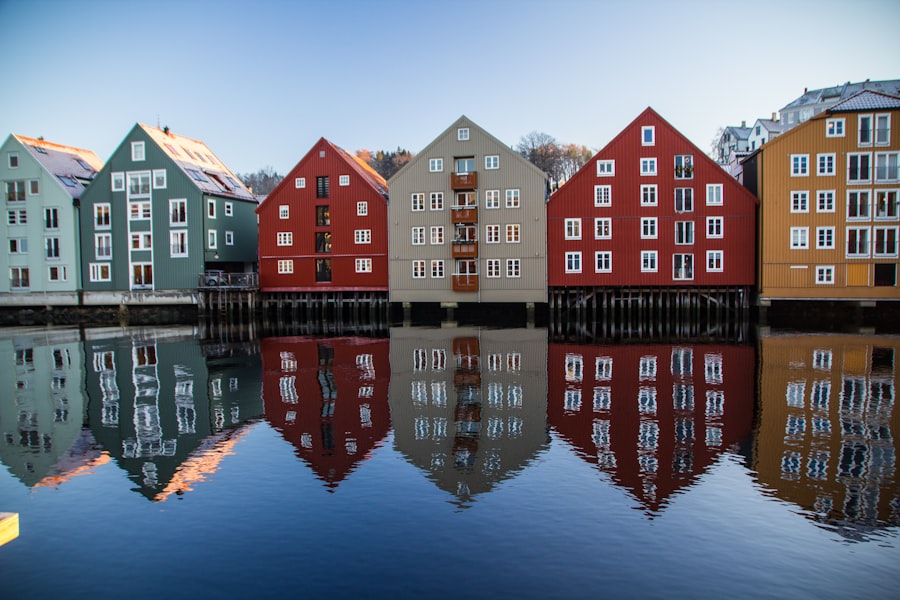The history of public cycling races in Norway is a rich tapestry woven with the threads of competition, community, and the love of the great outdoors. Cycling as a sport began to gain traction in Norway during the late 19th century, coinciding with the rise of the bicycle’s popularity across Europe. The first recorded cycling race took place in 1883, marking the beginning of a tradition that would grow to encompass a variety of events and attract participants from all walks of life.
Initially, these races were informal gatherings, often organised by local clubs, where cyclists would compete for bragging rights rather than formal accolades. As the 20th century progressed, cycling races began to evolve into more structured events, with the establishment of governing bodies and the introduction of rules and regulations. The Norwegian Cycling Federation was founded in 1900, which played a pivotal role in promoting cycling as a competitive sport.
Over the decades, public cycling races have transformed from local competitions into significant events that draw thousands of participants and spectators alike. The introduction of iconic races such as the Birkebeinerrittet in 1993 has further solidified Norway’s reputation as a cycling nation, showcasing the breathtaking landscapes while fostering a spirit of camaraderie among cyclists. Book your 1-hour strategy session with Norway Relocation Group.
Summary
- Public cycling races in Norway have a long history, dating back to the late 19th century.
- The most popular cycling races in Norway include the Tour of Norway and the Arctic Race of Norway.
- Public cycling races have had a significant impact on Norwegian culture, promoting a healthy and active lifestyle.
- To participate in public cycling races in Norway, individuals can register online or through local cycling clubs.
- Some of the best routes for public cycling races in Norway include the stunning landscapes of Lofoten and the challenging terrain of Rondane National Park.
The Most Popular Cycling Races in Norway
Norway boasts a plethora of cycling races that cater to both amateur and professional cyclists, each offering unique challenges and experiences. Among the most celebrated is the Birkebeinerrittet, which is not only one of the largest mountain bike races in Norway but also a cultural phenomenon. This race commemorates a historical event from 1206 when two Birkebeiner warriors transported the infant prince Haakon Haakonsson to safety.
The race covers a distance of 94 kilometres from Rena to Lillehammer, traversing stunning terrain that includes forests, mountains, and lakes, making it a must-do for cycling enthusiasts. Another notable event is the Tour des Fjords, which showcases Norway’s dramatic coastal scenery. This multi-stage race attracts both elite cyclists and amateurs who wish to experience the thrill of racing through some of the most picturesque landscapes in the world.
The event typically takes place in May and features various stages that challenge riders with steep climbs and exhilarating descents. Additionally, the Oslo Grand Prix is a popular urban race that draws crowds to the capital city, combining competitive racing with a vibrant atmosphere that celebrates cycling culture.
The Impact of Public Cycling Races on Norwegian Culture

Public cycling races have had a profound impact on Norwegian culture, fostering a sense of community and promoting an active lifestyle. These events serve as a platform for individuals from diverse backgrounds to come together, share their passion for cycling, and celebrate their achievements. The camaraderie built during these races often extends beyond the finish line, creating lasting friendships and connections among participants.
This sense of belonging is particularly evident in smaller towns where local races can become significant social events that unite residents. Moreover, public cycling races have contributed to a growing awareness of health and fitness in Norway. As more people participate in these events, there is an increasing emphasis on physical activity and its benefits for overall well-being.
This cultural shift has led to greater investment in cycling infrastructure, including dedicated bike lanes and trails, making it easier for individuals to incorporate cycling into their daily lives. The visibility of these races also inspires younger generations to take up cycling, ensuring that this beloved sport continues to thrive in Norwegian society.
How to Participate in Public Cycling Races in Norway
Participating in public cycling races in Norway is an exciting endeavour that requires some preparation and planning. First and foremost, aspiring participants should research upcoming events to find one that aligns with their skill level and interests. Many races offer categories for different abilities, from novice to expert, ensuring that everyone can find a suitable challenge.
Websites dedicated to cycling events often provide detailed information about registration processes, race routes, and any specific requirements. Once an event has been selected, it is essential to register well in advance, as many popular races can fill up quickly. Participants should also consider joining local cycling clubs or groups to gain insights from experienced cyclists who can offer valuable tips on training and race day strategies.
Engaging with the cycling community can enhance the overall experience and provide motivation during training sessions. Additionally, many races host pre-event workshops or meet-ups where participants can learn more about the course and connect with fellow cyclists.
The Best Routes for Public Cycling Races in Norway
Norway’s diverse landscape offers an array of breathtaking routes for public cycling races, each presenting its own unique challenges and scenic views. One of the most iconic routes is the Rena-Lillehammer stretch used in the Birkebeinerrittet. This course takes riders through lush forests and over rolling hills, providing stunning vistas that showcase Norway’s natural beauty.
The combination of technical terrain and picturesque surroundings makes this route a favourite among mountain bikers. Another remarkable route is found in the Lofoten Islands, where cyclists can experience dramatic coastal scenery while navigating winding roads that hug the shoreline. The Lofoten Cycle Route is renowned for its stunning landscapes, including towering mountains and pristine beaches.
This route not only offers an exhilarating ride but also allows participants to immerse themselves in the rich culture and history of the region. For those seeking a more urban experience, the Oslo Cycle Path provides an excellent opportunity to explore the capital city while enjoying dedicated bike lanes that make navigating through urban areas safe and enjoyable.
The Equipment Needed for Public Cycling Races in Norway

To ensure a successful experience in public cycling races, having the right equipment is crucial. A high-quality bicycle tailored to the specific type of race—be it road biking or mountain biking—is essential for optimal performance. Cyclists should invest in a bike that fits well and suits their riding style; this may involve consulting with experts at local bike shops for advice on selecting the right model.
In addition to a reliable bicycle, proper gear is vital for comfort and safety during races. Cyclists should wear padded shorts and moisture-wicking jerseys to enhance comfort over long distances. A well-fitted helmet is non-negotiable for safety reasons; it protects against potential injuries during falls or accidents.
Other essential equipment includes cycling shoes that provide better power transfer while pedalling, gloves for grip and comfort, and sunglasses to shield against glare from the sun or wind.
Tips for Training for Public Cycling Races in Norway
Training for public cycling races requires dedication and strategic planning to build endurance and improve performance. One effective approach is to create a structured training plan that gradually increases mileage over time while incorporating various types of rides—such as long-distance rides, interval training, and hill climbs—to develop different aspects of fitness. Consistency is key; setting aside specific days each week for training can help establish a routine that leads to gradual improvement.
Additionally, participating in group rides can be beneficial for motivation and skill development. Riding with others allows cyclists to push their limits while learning from more experienced riders. It also provides an opportunity to practice drafting techniques and pacing strategies that can be advantageous during races.
Furthermore, incorporating strength training into a weekly routine can enhance overall fitness by building core strength and improving stability on the bike.
The Health Benefits of Participating in Public Cycling Races
Engaging in public cycling races offers numerous health benefits that extend beyond physical fitness. Regular participation in cycling promotes cardiovascular health by improving heart function and increasing lung capacity. As cyclists train for races, they often experience weight loss or maintenance due to increased calorie expenditure during rides.
This can lead to improved body composition and reduced risk factors associated with obesity-related diseases. Moreover, cycling has been shown to have positive effects on mental health as well. The endorphins released during physical activity can alleviate symptoms of anxiety and depression while enhancing overall mood.
Participating in public races also fosters social connections that contribute to emotional well-being; sharing experiences with fellow cyclists creates a sense of belonging and support within the community.
The Environmental Impact of Public Cycling Races in Norway
Public cycling races play a significant role in promoting environmental sustainability by encouraging eco-friendly transportation alternatives. As more individuals take up cycling as a means of recreation or commuting, there is a corresponding reduction in carbon emissions associated with motor vehicles. This shift towards cycling not only benefits individual health but also contributes positively to air quality and reduces traffic congestion in urban areas.
Furthermore, many public cycling events are organised with sustainability in mind. Race organisers often implement measures such as waste reduction initiatives, recycling programmes, and partnerships with local environmental organisations to minimise their ecological footprint. By raising awareness about environmental issues through these events, organisers inspire participants to adopt more sustainable practices both on and off their bikes.
The Community Aspect of Public Cycling Races in Norway
The community aspect of public cycling races is one of their most cherished features, fostering connections among participants that extend beyond competition. These events often bring together individuals from diverse backgrounds who share a common passion for cycling, creating an inclusive atmosphere where friendships can flourish. Local communities rally around these races, providing support through volunteer efforts or simply by cheering on participants along the route.
Moreover, public cycling races often serve as fundraisers for local charities or initiatives, further strengthening community ties. By participating in these events, cyclists contribute not only to their own health but also to causes that benefit their communities at large. This sense of purpose enhances the overall experience for participants while reinforcing the idea that cycling is not just about individual achievement but also about collective impact.
The Future of Public Cycling Races in Norway
As interest in cycling continues to grow globally, the future of public cycling races in Norway looks promising. With advancements in technology and increased awareness about health and environmental issues, more individuals are likely to embrace cycling as both a sport and a mode of transportation. This trend may lead to an expansion of existing events as well as the creation of new races that cater to emerging interests within the cycling community.
Additionally, there is potential for greater integration between public cycling races and tourism initiatives aimed at showcasing Norway’s stunning landscapes. By promoting these events as part of broader travel experiences, organisers can attract international participants who wish to explore Norway’s natural beauty while engaging in competitive racing. As public cycling races continue to evolve alongside societal changes, they will undoubtedly remain an integral part of Norway’s cultural fabric for years to come.
In conclusion, if you are inspired by Norway’s vibrant cycling culture and wish to immerse yourself further into this beautiful country while learning its language, consider enrolling in Norwegian courses at the NLS Norwegian Language School in Oslo. Not only will you gain valuable language skills that enhance your experience during these events but also connect with fellow enthusiasts who share your passion for both cycling and Norwegian culture!
Speak Norwegian with confidence. Enroll in a class at the NLS Norwegian Language School now.

